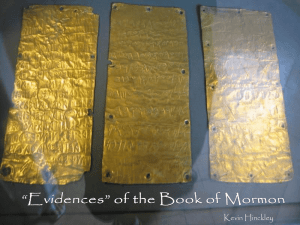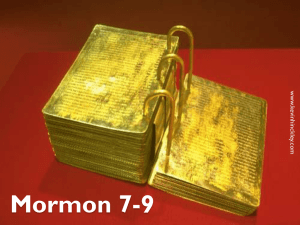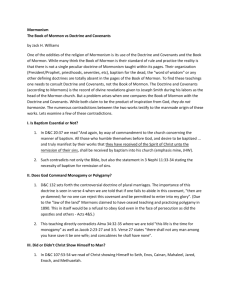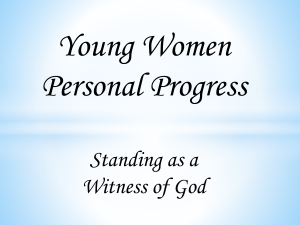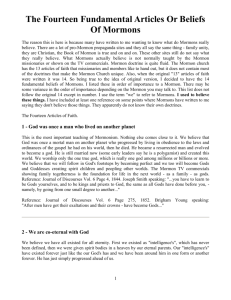"A Treasured Testament" by Russell M. Nelson
advertisement
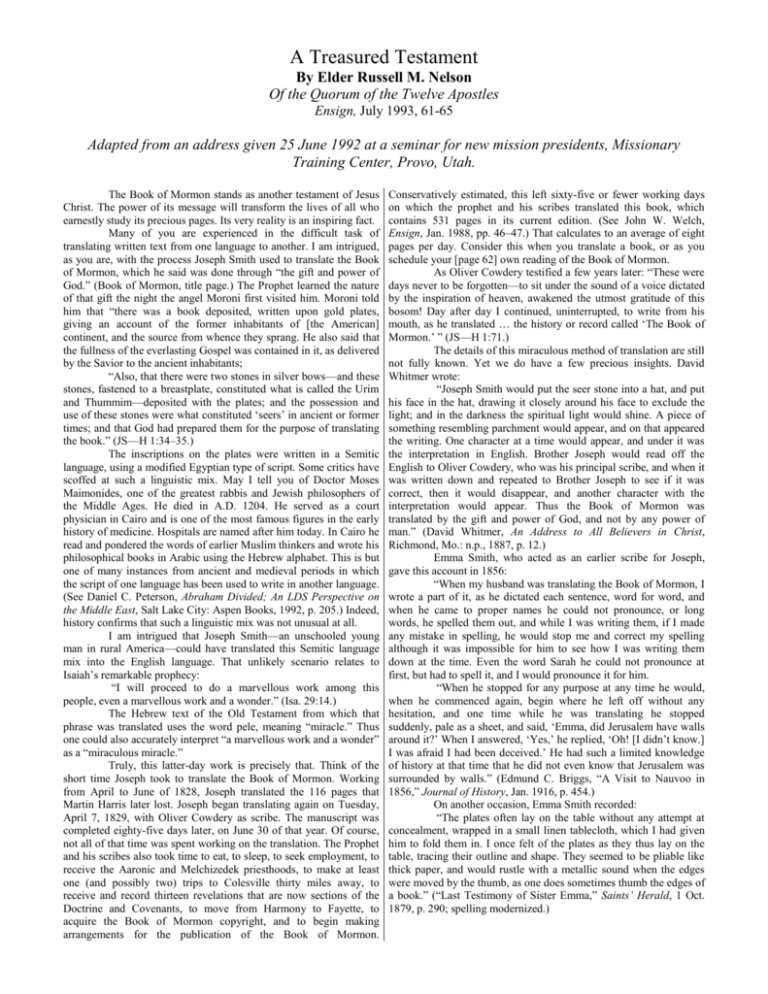
A Treasured Testament By Elder Russell M. Nelson Of the Quorum of the Twelve Apostles Ensign, July 1993, 61-65 Adapted from an address given 25 June 1992 at a seminar for new mission presidents, Missionary Training Center, Provo, Utah. The Book of Mormon stands as another testament of Jesus Christ. The power of its message will transform the lives of all who earnestly study its precious pages. Its very reality is an inspiring fact. Many of you are experienced in the difficult task of translating written text from one language to another. I am intrigued, as you are, with the process Joseph Smith used to translate the Book of Mormon, which he said was done through “the gift and power of God.” (Book of Mormon, title page.) The Prophet learned the nature of that gift the night the angel Moroni first visited him. Moroni told him that “there was a book deposited, written upon gold plates, giving an account of the former inhabitants of [the American] continent, and the source from whence they sprang. He also said that the fullness of the everlasting Gospel was contained in it, as delivered by the Savior to the ancient inhabitants; “Also, that there were two stones in silver bows—and these stones, fastened to a breastplate, constituted what is called the Urim and Thummim—deposited with the plates; and the possession and use of these stones were what constituted ‘seers’ in ancient or former times; and that God had prepared them for the purpose of translating the book.” (JS—H 1:34–35.) The inscriptions on the plates were written in a Semitic language, using a modified Egyptian type of script. Some critics have scoffed at such a linguistic mix. May I tell you of Doctor Moses Maimonides, one of the greatest rabbis and Jewish philosophers of the Middle Ages. He died in A.D. 1204. He served as a court physician in Cairo and is one of the most famous figures in the early history of medicine. Hospitals are named after him today. In Cairo he read and pondered the words of earlier Muslim thinkers and wrote his philosophical books in Arabic using the Hebrew alphabet. This is but one of many instances from ancient and medieval periods in which the script of one language has been used to write in another language. (See Daniel C. Peterson, Abraham Divided; An LDS Perspective on the Middle East, Salt Lake City: Aspen Books, 1992, p. 205.) Indeed, history confirms that such a linguistic mix was not unusual at all. I am intrigued that Joseph Smith—an unschooled young man in rural America—could have translated this Semitic language mix into the English language. That unlikely scenario relates to Isaiah’s remarkable prophecy: “I will proceed to do a marvellous work among this people, even a marvellous work and a wonder.” (Isa. 29:14.) The Hebrew text of the Old Testament from which that phrase was translated uses the word pele, meaning “miracle.” Thus one could also accurately interpret “a marvellous work and a wonder” as a “miraculous miracle.” Truly, this latter-day work is precisely that. Think of the short time Joseph took to translate the Book of Mormon. Working from April to June of 1828, Joseph translated the 116 pages that Martin Harris later lost. Joseph began translating again on Tuesday, April 7, 1829, with Oliver Cowdery as scribe. The manuscript was completed eighty-five days later, on June 30 of that year. Of course, not all of that time was spent working on the translation. The Prophet and his scribes also took time to eat, to sleep, to seek employment, to receive the Aaronic and Melchizedek priesthoods, to make at least one (and possibly two) trips to Colesville thirty miles away, to receive and record thirteen revelations that are now sections of the Doctrine and Covenants, to move from Harmony to Fayette, to acquire the Book of Mormon copyright, and to begin making arrangements for the publication of the Book of Mormon. Conservatively estimated, this left sixty-five or fewer working days on which the prophet and his scribes translated this book, which contains 531 pages in its current edition. (See John W. Welch, Ensign, Jan. 1988, pp. 46–47.) That calculates to an average of eight pages per day. Consider this when you translate a book, or as you schedule your [page 62] own reading of the Book of Mormon. As Oliver Cowdery testified a few years later: “These were days never to be forgotten—to sit under the sound of a voice dictated by the inspiration of heaven, awakened the utmost gratitude of this bosom! Day after day I continued, uninterrupted, to write from his mouth, as he translated … the history or record called ‘The Book of Mormon.’ ” (JS—H 1:71.) The details of this miraculous method of translation are still not fully known. Yet we do have a few precious insights. David Whitmer wrote: “Joseph Smith would put the seer stone into a hat, and put his face in the hat, drawing it closely around his face to exclude the light; and in the darkness the spiritual light would shine. A piece of something resembling parchment would appear, and on that appeared the writing. One character at a time would appear, and under it was the interpretation in English. Brother Joseph would read off the English to Oliver Cowdery, who was his principal scribe, and when it was written down and repeated to Brother Joseph to see if it was correct, then it would disappear, and another character with the interpretation would appear. Thus the Book of Mormon was translated by the gift and power of God, and not by any power of man.” (David Whitmer, An Address to All Believers in Christ, Richmond, Mo.: n.p., 1887, p. 12.) Emma Smith, who acted as an earlier scribe for Joseph, gave this account in 1856: “When my husband was translating the Book of Mormon, I wrote a part of it, as he dictated each sentence, word for word, and when he came to proper names he could not pronounce, or long words, he spelled them out, and while I was writing them, if I made any mistake in spelling, he would stop me and correct my spelling although it was impossible for him to see how I was writing them down at the time. Even the word Sarah he could not pronounce at first, but had to spell it, and I would pronounce it for him. “When he stopped for any purpose at any time he would, when he commenced again, begin where he left off without any hesitation, and one time while he was translating he stopped suddenly, pale as a sheet, and said, ‘Emma, did Jerusalem have walls around it?’ When I answered, ‘Yes,’ he replied, ‘Oh! [I didn’t know.] I was afraid I had been deceived.’ He had such a limited knowledge of history at that time that he did not even know that Jerusalem was surrounded by walls.” (Edmund C. Briggs, “A Visit to Nauvoo in 1856,” Journal of History, Jan. 1916, p. 454.) On another occasion, Emma Smith recorded: “The plates often lay on the table without any attempt at concealment, wrapped in a small linen tablecloth, which I had given him to fold them in. I once felt of the plates as they thus lay on the table, tracing their outline and shape. They seemed to be pliable like thick paper, and would rustle with a metallic sound when the edges were moved by the thumb, as one does sometimes thumb the edges of a book.” (“Last Testimony of Sister Emma,” Saints’ Herald, 1 Oct. 1879, p. 290; spelling modernized.) Although the Prophet would polish his skills over the years, Emma acknowledged that Joseph possessed only rudimentary literacy at the time he translated the gold plates: “Joseph Smith … could neither write nor dictate a coherent [page 63] and well-worded letter; let alone dictating a book like the Book of Mormon. And, though I was an active participant in the scenes that transpired, it is marvelous to me, ‘a marvel and a wonder,’ as much so as to any one else.” (Ibid.) Because the Book of Mormon is a translation of a modified Hebrew language, it contains many Hebraisms. We might list a few examples because they are so unlike the language that would have been familiar to a young man in rural New York at that time: • Nouns followed by descriptive phrases—such as “altar of stones,” “plates of brass,” “mist of darkness.” • Prepositional phrases used instead of adverbs—such as “with harshness,” “with joy,” “with gladness,” “in diligence.” • Cognate accusative constructions—“dreamed a dream,” “cursed with sore cursing,” “work all manner of fine work.” • Hebrew words with double meaning—such as Nahum, meaning “mourning,” and Jershon, meaning “inheritance.” Events involving those specific actions took place at locations bearing those meaningful names. • Chiasms. This term is derived from the Greek letter Chi (or the English x), which describes text written in an inverted parallel structure. As a young LDS missionary, John Welch discovered that many chiasms exist in the Book of Mormon as well as in the Bible. I am told that emphasis in these ancient languages was not provided by punctuation. Therefore, other devices, such as chiasm, were used occasionally to stress important thoughts. Sister Nelson and I have a close friend and former neighbor, Sami Hanna, who was born in Egypt. He is a scholar with special expertise in Semitic languages. As a linguistic exercise, he translated the Book of Mormon from English into Arabic. The exercise converted him to the divinity of the Book of Mormon. Among the many linguistic features that convinced him of the book’s divinity was this unusual sentence in Helaman, chapter 3, verse 14. [Hel. 3:14] This would hardly be an expression of a 24-year-old man from the New York frontier: “But behold, a hundredth part of the proceedings of this people, yea, the account of the Lamanites and of the Nephites, and their wars, and contentions, and dissensions, and their preaching, and their prophecies, and their shipping and their building of ships, and their building of temples, and of synagogues and their sanctuaries, and their righteousness, and their wickedness, and their murders, and their robbings, and their plundering, and all manner of abominations and whoredoms, cannot be contained in this work.” That single sentence has eighteen ands. Now, if you were a teacher of English you might tend to downgrade the composition of that sentence. Yet my scholarly Egyptian friend said that every one of those ands was an important element in the construction of that sentence, allowing his translation to flow smoothly back to a Semitic language. Of course the great worth of the Book of Mormon lies not in its miraculous translation, wondrous as it was, nor in its stories that we read to our children. The great worth of the Book of Mormon is that it is another testament of Jesus Christ. All four of its major authors—Nephi, Jacob, Mormon, and Moroni—were eyewitnesses of the Lord, as was His inspired translator of that book. The Book of Mormon is the great clarifier of doctrine. It refutes many myths, and at the same time affirms truths previously obscured. And it reveals many glorious doctrines lost or previously unknown. First let us examine a few myths the book refutes or denies. The Book of Mormon refutes the doctrine of predestination. It refutes the ex nihilo (“out of nothing”) idea of creation. It refutes the false but pervasive notion of original sin. It refutes the fable of faith without works. It refutes the adequacy of goodness alone without exalting ordinances. It refutes the practice of infant baptism. It refutes methods of baptism other than that of immersion by one bearing proper authority. It refutes the arbitrary restriction that revelation from God ended with the Bible. There are some things that the Book of Mormon is not. It is not a text of history, although some history is found within its pages. It is not a definitive work on ancient American agriculture or politics. It is not a record of all former inhabitants of the Western Hemisphere, but only of particular groups of people. Resoundingly, the Book of Mormon affirms, among many eternal truths, the existence of a living and loving Father in Heaven. It affirms the nature of our Heavenly Father’s plan of salvation, happiness, and mercy. It declares, as another testament, the generation and divinity of Jesus the Christ. It teaches of His ministry, and of His atonement. While doubts about Jesus exist among today’s ministers and scholars, the Book of Mormon stands as an international beacon of divine truth. The Lord said: “The testimony of two nations is a witness unto you that I am God, that I remember one nation [page 64] like unto another. … And when the two nations shall run together the testimony of the two nations shall run together also.” (2 Ne. 29:8.) The Book of Mormon affirms the sublime status of man’s moral agency and sets forth stern standards of accountability and responsibility for our choices. It affirms the reality and inevitability of our impending judgment, which will be done with a perfect blending of the justice and mercy of God. (See Alma 12:15.) It deepens our understanding of the Master’s statement once made near Galilee’s shore: “Be ye therefore perfect, even as your Father which is in heaven is perfect.” (Matt. 5:48.) To the Nephites Jesus reaffirmed that commandment, but then as the resurrected Lord, He listed Himself as having recently achieved that state of perfection. (See 3 Ne. 12:48.) The Book of Mormon affirms that the people in the Western Hemisphere were among the “other sheep” to whom Jesus had earlier referred. (See John 10:16; 3 Ne. 15:17, 21.) And it affirms the existence of another society to whom Jesus would minister— those we know as the lost tribes of Israel. It affirms the reality of premortal life. It reaffirms the sanctity of and the necessity for the sacrament, as taught in the Bible. In addition to the refutation of myths and the clarification of concepts previously unclear, the Book of Mormon reveals glorious truths heretofore lost or unknown to the mind of man: It reveals the state of the soul between death and resurrection. It reveals the endless nature of the priesthood of God and the foreordination of choice spirits called and prepared from the foundation of the world for leadership in the latter days. From the Book of Mormon we know that each of you has been foreordained, foredetermined, and reserved to come forth at this particular time to accomplish the mighty work you have been called to do. The Book of Mormon reveals what the term gospel truly means. The Lord declared, “This is the gospel which I have given unto you—that I came into the world to do the will of my Father, because my Father sent me.” (3 Ne. 27:13.) That sentence is as sparklingly clear as it is brief. The Savior then explained in fuller detail His mission and His atonement (see 3 Ne. 27:13–21), concluding His definitions by again saying, “This is my gospel” (3 Ne. 27:21). The Book of Mormon reveals the important interrelationships between the Creation, the Fall, and the Atonement. One cannot fully comprehend the Atonement without first understanding the Fall; and the fall of Adam cannot be fully understood without first understanding the Creation. These three great doctrinal pillars sustain each other in God’s eternal plan. The Book of Mormon reveals that Joseph, the son of Jacob who was once sold into Egypt, foresaw the Prophet Joseph Smith and his day (see 2 Ne. 3:6–21) and noted that there would be many similarities in their lives. Centuries later, the Prophet Joseph stated, “I feel like Joseph in Egypt.” (The Personal Writings of Joseph Smith, ed. Dean C. Jessee, Salt Lake City: Deseret Book Co., 1984, p. 409; spelling modernized.) The Book of Mormon reveals that the inheritance of Joseph, son of Israel, was not forgotten when, as promised in the Abrahamic covenant, land was distributed to the tribes of Israel. Joseph’s inheritance was to be a land choice above all others. (See Ether 13:2, 8.) It was choice not because of beauty or wealth of natural resources, but choice because it was chosen. It was to be the repository of sacred writing on plates of gold from which the Book of Mormon would one day come, choice because it would eventually host world headquarters of the restored church of Jesus Christ in the latter days. The Book of Mormon reveals that Jesus of Nazareth, born of Mary, is literally the Son of God. No book of scripture bears more solemnly the weighty burden of that testimony than does the Book of Mormon. Its pages contain nearly four thousand references to Christ, using more than one hundred different titles for Him. His holy name is mentioned on the average of once per every 2.8 verses. No wonder this book has been designated “Another Testament of Jesus Christ.” The Book of Mormon reveals that the keeper of the gate at Judgment will be Jesus, the holy one of Israel. There each one of us will stand before Him to be judged. The Book of Mormon contains many insightful and stunning gems. The late Elder Robert E. Sackley of the Seventy attributed his conversion to this brilliant passage of scripture, which he memorized while hospitalized as a young military commando— even prior to his baptism: “The natural man is an enemy to God, and has been from the fall of Adam, and will be, forever and ever, unless he yields to the enticings of the Holy Spirit, and putteth off the natural man and becometh a saint through the atonement of Christ the Lord, and becometh as a child, submissive, meek, humble, [page 65] patient, full of love, willing to submit to all things which the Lord seeth fit to inflict upon him, even as a child doth submit to his father.” (Mosiah 3:19.) Elder Sackley’s life was never to be the same after his decision to live in accord with that remarkable single sentence of scripture. To me, the truthfulness of the Book of Mormon is most evident in the mighty change that comes into the lives of those who read it “with a sincere heart, with real intent, having faith in Christ.” (Moro. 10:4.) Many of them forsake much that they held dear to be true to their new commitment to abide by the precepts of that book. The Book of Mormon truly is a treasured testament. There is no other book quite like it. Can you find any other book delivered by an angel? Can you think of any other book prepared for people to read centuries later? Its writers did not write it for readers of their day. No royalties accrued to its authors from sales to contemporary consumers. In fact, its authors paid dearly for their privilege of authorship, as did its translator. It is a book that the Lord Jesus Christ has personally testified to be true. In the form of an oath, the Lord said—referring to the Prophet Joseph Smith’s work: “He has translated the book, even that part which I have commanded him, and as your Lord and your God liveth it is true.” (D&C 17:6.) You know well this promise that the Lord offers to readers of the Book of Mormon: “If you do these last commandments of mine, which I have given you, the gates of hell shall not prevail against you; for my grace is sufficient for you, and you shall be lifted up at the last day.” (D&C 17:8.) The Prophet Joseph Smith declared—and his successor, President Ezra Taft Benson, has reaffirmed—that the Book of Mormon is the keystone of our religion. It is a treasured testament of truth. It is the prophesied sign that “the Lord has commenced to gather Israel and fulfill his covenants.” (3 Ne. 29, chapter heading.) Solemnly, I add my witness to that of my Brethren. It is true! In the name of Jesus Christ, amen.
